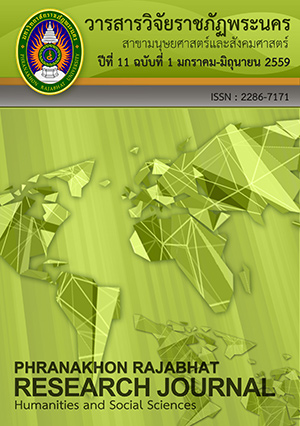ผลการจัดกิจกรรมเคลื่อนไหวเชิงพิลาทีสที่มีต่อพัฒนาการด้านร่างกายของเด็กปฐมวัย
Main Article Content
Abstract
THE EFFECT OF PILATES MOVEMENT ACTIVITY ON PHYSICAL DEVELOPMENT OF PRESCHOOL CHILDREN
การวิจัยครั้งนี้มีจุดมุ่งหมายเพื่อศึกษาระดับและการเปลี่ยนแปลงพัฒนาการด้านร่างกายโดยรวมและรายทักษะของเด็กปฐมวัยที่เกิดจากการจัดกิจกรรมเคลื่อนไหวเชิงพิลาทีส กลุ่มตัวอย่างที่ใช้ในการศึกษาครั้งนี้เป็นนักเรียนชาย - หญิง อายุระหว่าง 3 - 4 ปี ชั้นอนุบาลปีที่ 1 ภาคเรียนที่ 2 ปีการศึกษา 2557 โรงเรียนคลองขวาง ตำบลท่ากุ่ม อำเภอเมืองตราด จังหวัดตราด ซึ่งได้มาโดยวิธีการเลือกแบบเจาะจง 1 ห้องเรียนและจับสลากเด็ก จำนวน 20 คน ใช้เป็นกลุ่มทดลองเพื่อจัดกิจกรรมเคลื่อนไหวเชิงพิลาทีสเป็นเวลา 8 สัปดาห์สัปดาห์ละ 4 วัน วันละ 25 นาที เครื่องมือที่ใช้ในการวิจัยคือ แผนการจัดกิจกรรมเคลื่อนไหวเชิงพิลาทีสและแบบทดสอบเชิงปฏิบัติพัฒนาการด้านร่างกายที่ผู้วิจัยสร้างขึ้น ซึ่งมีค่าความเชื่อมั่นทั้งฉบับเท่ากับ .80 ในการวิจัยครั้งนี้ใช้แบบแผนการทดลองแบบ One-Group Pretest-Posttest Design และสถิติที่ใช้ในการวิเคราะห์ข้อมูล คือ t-test แบบ Dependent Samples ผลการวิจัยพบว่า เด็กปฐมวัยที่ได้รับการจัดกิจกรรมเคลื่อนไหวเชิงพิลาทีสก่อนและหลังการทดลอง มีระดับคะแนนพัฒนาการด้านร่างกายแตกต่างกันอย่างมีนัยสำคัญทางสถิติที่ระดับ p<.01 ทั้งโดยรวม ( = 17.10, t = 20.48) และรายทักษะ คือ ทักษะการเดิน ( = .81, t = 14.91) ทักษะการยืน ( = .72, t = 11.53) ทักษะการกระโดด ( = .92,t = 12.90) โดยการจัดกิจกรรมเคลื่อนไหวเชิงพิลาทีสส่งผลต่อพัฒนาการด้านร่างกายโดยรวมร้อยละ 79(EI = .79) และรายทักษะคือ ทักษะการเดินร้อยละ 73 (EI = .73) ทักษะการยืนร้อยละ 80 (EI = .80) และทักษะการกระโดดร้อยละ 85 (EI = .85) ตามลำดับ แสดงว่าการจัดกิจกรรมเคลื่อนไหวเชิงพิลาทีส ช่วยให้พัฒนาการด้านร่างกายของเด็กปฐมวัยโดยรวมและรายทักษะเปลี่ยนแปลงเพิ่มขึ้นอย่างชัดเจน
The main purpose of this research was to study the physical development levels
and changes of preschool children both in overall and in individual skills through the use
of pilates movement activity. The samples used in the study were 4-5 year-preschool
boys and girls, who were studying in the frst year preschool at second semester of 2014
academic year at Khlongkhwang School in Thakam Sub-district, Mueang District, Trat
Province. One class was selected by purposive sampling and then 20 children were chosen
by drawing and used as the experimental group with the use of Pilates movement activity
within the period of 8 weeks, 4 days a week, and 25 minutes for each day. The research
instruments were the plans for Pilates movement activity and the performance test
of physical development with the reliability of the whole paper at .80. The research
followed the one group pretest-posttest design and the data were statistically analyzed
by using dependent sample t-test. The research results revealed that, before and after the
use of Pilates movement activity, the score levels of physical development of preschool
children were different with statistical signifcance at the level of p<.01 both in general
( = 17.10, t = 20.48) and in individual areas of walking skill ( = .81, t = 14.91), standing
skill ( = .72, t = 11.53) and jumping skill ( = .92, t = 12.90). The Pilates movement
activity provided the effects on their physical development in general at 79% (EI = .79)
and in individual areas of walking skill at 73% (EI = .73), standing skill at 80% (EI = .80)
and jumping skill at 85% (EI = .85), respectively. The results indicated that the Pilates
movement activity could obviously improve the changes in physical development of
preschool children both in general and in individual skills.
Article Details
Each publish articles were copyright by Phranakorn Rajabhat University
Any contents which appeared in each articles in the journal were authors personal opinion. It did not relate to Phranakorn Rajabhat University and other instructors in the university. Each authors would take responsibility on their articles. If there are any mistake, the authors will take responsibility themselves


